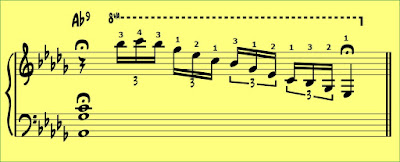I had the transcription, and I was fascinated mainly because he was actually playing 'live' all those wonderful arranging concepts I'd been interested in, but never really knew how it could be incorporated into jazz improvisation before. Maybe it sounds dumb to some people. It's hard to explain what exactly motivated me to explore Tatum, because as a piano player I had nowhere near the level of requisite technique usually associated with attempting anything Tatum-esque. Maybe it was because I was such a novice in comparison, I had nothing to lose, in a way: it's like a mountain peak that you're forever striving to reach. And I like an impossible challenge. There aren't too many musicians in history that we can say are close to perfection, but I think Art Tatum is one of them. If we had recordings of J. S. Bach or Chopin, we might all agree on that point.
But jazz is all about making whatever it is you like into your own, so that you own it. Whether I'm playing some Tatum-inspired phrase at 1/10 or even 1/100th the speed and accuracy he played, doesn't matter to me in the slightest. What matters to me is if I can use his concepts in my own playing, to make them mean something, truly incorporating them into my own playing. It can't sound forced. In the literature you will find many jazz commentators who'll tell you Tatum wasn't really 'jazz' because he played the same arrangement all the time. But these people have no idea what a working musician's life was like back then - and I mean a solo pianist's working life. You have to have a plan, a structure, some kind of edifice on which to build your sandcastles.
Tatum was legally blind, yet he mastered not only the 'licks' of the classical repertoire (to put it crudely), but also the whole gamut of jazz piano: so much so that he is a virtual compendium of the complete history of jazz piano, with foreshadowings of the future.
This track was recorded near the end of his life, in the marathon Norman Granz sessions for Verve Records in January 1955. But you gotta hear the mid-1930s Tatum to fully appreciate what he could do and what he meant for musicians of the time.
This was the lick that first got me - the D13 and how it resolved to the Dm in the key of C. The following excerpt is the first seven bars from Jed Distler's Art Tatum Jazz Masters Series, an invaluable book of Tatum's transcriptions. And with acknowledgements by the likes of Dick Hyman and Felicity Howlett (whose thesis I've yet to read), this is an authoritative document.
here is the D13 lick excerpted from bar 6:
the audio excerpt, from a bar before:
This is a great example of the famous 2-1 fingering for which he was famous:
How simple and beautiful!
Once you get the idea, you can expand the concept to the other 13ths.
The point being, the 13th chord is the quintessential jazz chord, the sound that is so captivating to the humans that are really awake out there. As I pointed out in earlier posts, this sound was first introduced through classical music, Ravel and Debussy, but I'm sure it can be traced back much further.
In our next post we'll look at the 13th chord conceptually, and the ridiculous attempts by Wickedpedia to muddy the issue, you can bet on purpose.
























